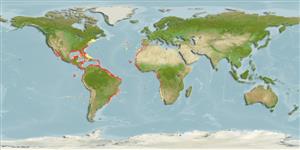Environment: milieu / climate zone / depth range / distribution range
Sinh thái học
Biển; Nước ngọt; Thuộc về nước lợ Cùng sống ở rạn san hô; Di cư sông biển (để đẻ trứng) (Ref. 51243); Mức độ sâu 0 - 300 m, usually 0 - 20 m. Subtropical; 43°N - 34°S, 114°W - 16°E
Western Atlantic: Nova Scotia, but uncommon north of Cape Cod (Harrison, pers. Comm.) to Argentina (Ref. 74796). Eastern Atlantic: Senegal River outlet (Ref. 57400) southwards up to Namibia (Ref. 81659). Eastern Pacific: Gulf of California to Chile (Ref. 9321, 81659).
Length at first maturity / Bộ gần gũi / Khối lượng (Trọng lượng) / Age
Maturity: Lm 19.7, range 21 - ? cm
Max length : 91.0 cm TL con đực/không giới tính; (Ref. 81659); common length : 30.0 cm TL con đực/không giới tính; (Ref. 9321); Khối lượng cực đại được công bố: 680.00 g (Ref. 40637)
Các tia vây lưng cứng (tổng cộng) : 4 - 5; Các vây lưng mềm (tổng cộng) : 8 - 9; Tia cứng vây hậu môn: 3; Tia mềm vây hậu môn: 9 - 10. Diagnosis: body stout, rounded in cross-section; head broad; inter-orbital space flat; a well developed adipose eyelid covering most of pupil (Ref. 57400). Upper lip simple, thicker and deeper than in most Mugil species, armed with 2-3 rows (Ref. 57400), teeth in outer row curved, monocuspid (Ref. 57400, 81659) and moderately close-set (Ref. 81659) or widely spaced (Ref. 57400), inner row of less closely set, smaller teeth may be present just posterior to outer row (Ref. 81659). Lower lip with single row of unicuspid teeth, usually smaller than teeth in outer row on upper lip (Ref. 81659). A vertical line from hind end of upper jaw positioned midway between posterior nostril and anterior eye margin; maxillary pad not visible below corner of mouth when closed; origin of 1st dorsal fin equidistant from snout tip and caudal-fin base; pectoral axillary process well developed (30-37% of pectoral-fin length)(Ref. 57400). (Second) dorsal and anal fins entirely (and more or less densely) covered with scales (Ref. 57400, 81659). Anal fin usually III-9 (rarely III-10) in adults (usually II-10 in juveniles <30 mm SL), first spine very short and usually hidden by overlying scales (Ref. 81659). 11-13 scale rows between origins of first dorsal and pelvic fins (Ref. 57400, 81659).
Inhabit sandy coasts and littoral pools but also occurs in muddy bottoms of brackish lagoons and estuaries. Sometimes penetrate rivers. May also be found on coral reefs (Ref. 9710). Juveniles are common in coastal waters and are known to find their way to estuaries and coastal lagoons. Growth in juveniles is moderate (30-40 cm in 4 years). Adults form schools (Ref. 9321). Feed on microscopic or filamentous algae and small juveniles of planktonic organisms (Ref. 9626). Reproduction occurs between March and August. Spawn several million eggs provided with a notable yolk (Ref. 35237). Oviparous, eggs are pelagic and non-adhesive (Ref. 205). Maximul size 910 mm TL for western Central Atlantic specimens, eastern Central Atlantic specimens may reach 350 mm TL and commonly reach 250 mm TL (Ref. 81659). An important foodfish, it is marketed fresh and salted (Ref. 9321).
Robins, C.R. and G.C. Ray, 1986. A field guide to Atlantic coast fishes of North America. Houghton Mifflin Company, Boston, U.S.A. 354 p. (Ref. 7251)
IUCN Red List Status (Ref. 130435: Version 2024-2)
Threat to humans
Harmless
Human uses
Các nghề cá: Tính thương mại; Nuôi trồng thủy sản: Tính thương mại; cá để chơi: đúng; mồi: occasionally
Các công cụ
Special reports
Download XML
Các nguồn internet
Estimates based on models
Preferred temperature (Ref.
123201): 21 - 28, mean 26.1 °C (based on 798 cells).
Phylogenetic diversity index (Ref.
82804): PD
50 = 0.5000 [Uniqueness, from 0.5 = low to 2.0 = high].
Bayesian length-weight: a=0.01175 (0.01005 - 0.01373), b=2.95 (2.92 - 2.98), in cm total length, based on LWR estimates for this species (Ref.
93245).
Mức dinh dưỡng (Ref.
69278): 2.0 ±0.0 se; based on diet studies.
Thích nghi nhanh (Ref.
120179): Trung bình, thời gian nhân đôi của chủng quần tối thiểu là 1.4 - 4.4 năm (tm=2-3; Fec=>50,000).
Fishing Vulnerability (Ref.
59153): High vulnerability (56 of 100).
Nutrients (Ref.
124155): Calcium = 41.8 [12.1, 129.8] mg/100g; Iron = 1.16 [0.21, 6.72] mg/100g; Protein = 20.4 [18.6, 22.0] %; Omega3 = 0.289 [0.115, 0.777] g/100g; Selenium = 47.2 [14.8, 166.0] μg/100g; VitaminA = 23.8 [5.1, 118.5] μg/100g; Zinc = 1.75 [0.78, 4.50] mg/100g (wet weight);
